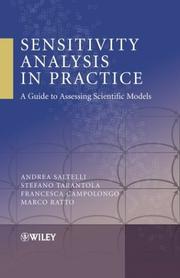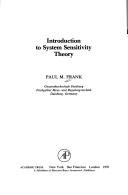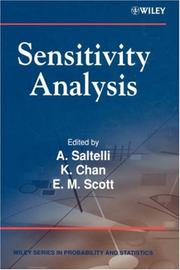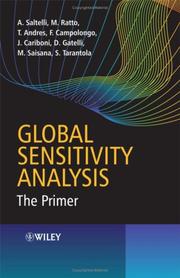
ISBN: 9780470870938 0470870931 Year: 2004 Publisher: Hoboken, N.J. Wiley
Abstract | Keywords | Export | Availability | Bookmark
 Loading...
Loading...Choose an application
- Reference Manager
- EndNote
- RefWorks (Direct export to RefWorks)
Sensitivity analysis should be considered a pre-requisite for statistical model building in any scientific discipline where modelling takes place. For a non-expert, choosing the method of analysis for their model is complex, and depends on a number of factors. This_ book guides the non-expert through their problem in order to enable them to choose and apply the most appropriate method. It offers a review of the state-of-the-art in sensitivity analysis, and is suitable for a wide range of practitioners. It is focussed on the use of SIMLAB & a widely distributed freely-available sensitivity analysis software package developed by the authors & for solving problems in sensitivity analysis of statistical models. Other key features: Provides an accessible overview of the current most widely used methods for sensitivity analysis. Opens with a detailed worked example to explain the motivation behind the book. Includes a range of examples to help illustrate the concepts discussed. Focuses on implementation of the methods in the software SIMLAB - a freely-available sensitivity analysis software package developed by the authors. Contains a large number of references to sources for further reading.
Sensitivity theory (Mathematics) --- SIMLAB --- SIMLAB. --- Simulation methods. --- Mathematical statistics --- Simulation methods --- Computer simulation --- Simulation par ordinateur --- Simulation, méthodes de

ISBN: 0122656504 9780122656507 Year: 1978 Publisher: New York (N.Y.): Academic press
Abstract | Keywords | Export | Availability | Bookmark
 Loading...
Loading...Choose an application
- Reference Manager
- EndNote
- RefWorks (Direct export to RefWorks)
System analysis --- Sensitivity theory (Mathematics) --- 519.71 --- Network theory --- Systems analysis --- System theory --- Mathematical optimization --- Sensitivity (Mathematics) --- System sensitivity theory (Mathematics) --- Control theory --- Control systems theory: mathematical aspects --- System analysis. --- 519.71 Control systems theory: mathematical aspects --- Sensitivity theory (Mathematics). --- Network analysis --- Network science
Book
ISBN: 0387547614 Year: 1994 Publisher: Berlin : Springer-Verlag,
Abstract | Keywords | Export | Availability | Bookmark
 Loading...
Loading...Choose an application
- Reference Manager
- EndNote
- RefWorks (Direct export to RefWorks)
Book
ISBN: 9781611976687 Year: 2021 Publisher: Philadelphia : Society for Industrial and Applied Mathematics,
Abstract | Keywords | Export | Availability | Bookmark
 Loading...
Loading...Choose an application
- Reference Manager
- EndNote
- RefWorks (Direct export to RefWorks)
"This book provides an overview of global sensitivity analysis methods and algorithms, including their theoretical basis and mathematical properties" [Publisher]

ISBN: 0471998923 Year: 2000 Publisher: Chichester Wiley
Abstract | Keywords | Export | Availability | Bookmark
 Loading...
Loading...Choose an application
- Reference Manager
- EndNote
- RefWorks (Direct export to RefWorks)
Sensitivity theory (Mathematics) --- Basic Sciences. Statistics --- Statistical methods. --- Statistics (General) --- Statistics (General). --- 511.8 --- 305.970 --- AA / International- internationaal --- Sensitivity (Mathematics) --- System sensitivity theory (Mathematics) --- Statistical methods --- Algemeenheden: Autoregression and moving average representation. ARIMA. ARMAX. Lagrange multiplier. Wald. Function (mis) specification. Autocorrelation. Homoscedasticity. Heteroscedasticity. ARCH. GARCH. Integration and co-integration. Unit roots --- Control theory
Book
ISBN: 9811302308 9811302294 Year: 2019 Publisher: Singapore : Springer Singapore : Imprint: Springer,
Abstract | Keywords | Export | Availability | Bookmark
 Loading...
Loading...Choose an application
- Reference Manager
- EndNote
- RefWorks (Direct export to RefWorks)
This book presents a comprehensive introduction to design sensitivity analysis theory as applied to electromagnetic systems. It treats the subject in a unified manner, providing numerical methods and design examples. The specific focus is on continuum design sensitivity analysis, which offers significant advantages over discrete design sensitivity methods. Continuum design sensitivity formulas are derived from the material derivative in continuum mechanics and the variational form of the governing equation. Continuum sensitivity analysis is applied to Maxwell equations of electrostatic, magnetostatic and eddy-current systems, and then the sensitivity formulas for each system are derived in a closed form; an integration along the design interface. The book also introduces the recent breakthrough of the topology optimization method, which is accomplished by coupling the level set method and continuum design sensitivity. This topology optimization method enhances the possibility of the global minimum with minimised computational time, and in addition the evolving shapes during the iterative design process are easily captured in the level set equation. Moreover, since the optimization algorithm is transformed into a well-known transient analysis algorithm for differential equations, its numerical implementation becomes very simple and convenient. Despite the complex derivation processes and mathematical expressions, the obtained sensitivity formulas are very straightforward for numerical implementation. This book provides detailed explanation of the background theory and the derivation process, which will help readers understand the design method and will set the foundation for advanced research in the future.
Electromagnetic devices --- Sensitivity theory (Mathematics) --- Mathematical models. --- Electronics. --- Production of electric energy or. --- Electronics and Microelectronics, Instrumentation. --- Continuous Optimization. --- Power Electronics, Electrical Machines and Networks. --- Electrical engineering --- Physical sciences

ISBN: 9780470059975 0470059974 Year: 2008 Publisher: Chichester, England : John Wiley,
Abstract | Keywords | Export | Availability | Bookmark
 Loading...
Loading...Choose an application
- Reference Manager
- EndNote
- RefWorks (Direct export to RefWorks)
"Mathematical models are good at mapping assumptions into inferences. A modeller makes assumptions about laws pertaining to the system, about its status and a plethora of other, often arcane, system variables and internal model settings. To what extent can we rely on the model-based inference when most of these assumptions are fraught with uncertainties? Global Sensitivity Analysis offers an accessible treatment of such problems via quantitative sensitivity analysis, beginning with the first principles and guiding the reader through the full range of recommended practices with a rich set of solved exercises. The text explains the motivation for sensitivity analysis, reviews the required statistical concepts, and provides a guide for potential applications." "Postgraduate students and practitioners in a wide range of subjects, including statistics, mathematics, engineering, physics, chemistry, environmental sciences, biology, toxicology, actuarial sciences, and econometrics will find much of use here. This book will prove equally valuable to engineers working on risk analysis and to financial analysts concerned with pricing and hedging."--Jacket.
Sensitivity theory (Mathematics) --- Global analysis (Mathematics) --- Mathematical models. --- Basic Sciences. Mathematics --- Mathematical Models, Simulation Models --- Sensitivity theory (Mathematics). --- Global analysis (Mathematics). --- Mathematical Models, Simulation Models. --- Statistique mathématique --- Mathematical statistics --- Mathematical models --- Models, Mathematical --- Simulation methods --- Analysis, Global (Mathematics) --- Differential topology --- Functions of complex variables --- Geometry, Algebraic --- Sensitivity (Mathematics) --- System sensitivity theory (Mathematics) --- Control theory --- wiskundige modellen --- mathematical models --- gevoeligheidsanalyse --- sensitivity analysis --- Wiskundige modellen, simulatiemodellen --- 681.3*F41 --- 681.3*F41 Mathematical logic: computability theory; computational logic; lambda calculus; logic programming; mechanical theorem proving; model theory; proof theory;recursive function theory--See also {681.3*F11}; {681.3*I22}; {681.3*I23} --- Mathematical logic: computability theory; computational logic; lambda calculus; logic programming; mechanical theorem proving; model theory; proof theory;recursive function theory--See also {681.3*F11}; {681.3*I22}; {681.3*I23} --- Statistique mathématique
Book
ISBN: 1902902572 9781902902579 Year: 2007 Publisher: London AA Publications
Abstract | Keywords | Export | Availability | Bookmark
 Loading...
Loading...Choose an application
- Reference Manager
- EndNote
- RefWorks (Direct export to RefWorks)
Evolutionary computation. --- Architecture --- Sensitivity theory (Mathematics) --- Structural optimization. --- Réseaux neuronaux à structure évolutive --- Théorie de la sensibilité (Mathématiques) --- Optimisation des structures --- Technological innovations. --- Computer-aided design. --- Innovations --- Conception assistée par ordinateur --- Sasaki, Mutsuro --- Réseaux neuronaux à structure évolutive --- Théorie de la sensibilité (Mathématiques) --- Conception assistée par ordinateur
Multi
ISBN: 9783031196355 9783031196348 9783031196362 9783031196379 Year: 2023 Publisher: Cham Springer International Publishing
Abstract | Keywords | Export | Availability | Bookmark
 Loading...
Loading...Choose an application
- Reference Manager
- EndNote
- RefWorks (Direct export to RefWorks)
This text describes a comprehensive adjoint sensitivity analysis methodology (C-ASAM), developed by the author, enabling the efficient and exact computation of arbitrarily high-order functional derivatives of model responses to model parameters in large-scale systems. The C-ASAM framework is set in linearly increasing Hilbert spaces, each of state-function-dimensionality, as opposed to exponentially increasing parameter-dimensional spaces, thereby breaking the so-called “curse of dimensionality” in sensitivity and uncertainty analysis. The C-ASAM applies to any model; the larger the number of model parameters, the more efficient the C-ASAM becomes for computing arbitrarily high-order response sensitivities. The book will be helpful to those working in the fields of sensitivity analysis, uncertainty quantification, model validation, optimization, data assimilation, model calibration, sensor fusion, reduced-order modelling, inverse problems and predictive modelling. This Volume Two, the second of three, presents the large-scale application of C-ASAM to compute exactly the first-, second-, third-, and fourth-order sensitivities of the Polyethylene-Reflected Plutonium (PERP) OECD/NEO international benchmark which is modeled mathematically by the Boltzmann particle transport equation. It follows from the description of the C-ASAM framework applied to linear systems in Volume One where the PERP benchmark's response of interest is the leakage of particles through its outer boundary. The benchmark represents the largest sensitivity analysis endeavor ever carried out in the field of reactor physics and the numerical results shown in this book prove, for the first time ever, that many of the second-order sensitivities are much larger than the corresponding first-order ones. Currently, the nth-CASAM is the only known methodology which enables such large-scale computations of the exact expressions and values of the nth-order response sensitivities.
Statistical science --- Mathematics --- Mathematical physics --- Nuclear physics --- Relation between energy and economics --- Applied physical engineering --- Engineering sciences. Technology --- Planning (firm) --- Artificial intelligence. Robotics. Simulation. Graphics --- Computer. Automation --- energiebeheer (technologie) --- energiemanagement (economie) --- ICT (informatie- en communicatietechnieken) --- energiebeleid --- energie-economie --- economie --- mathematische modellen --- statistiek --- mineralen (chemie) --- mijnbouw --- wiskunde --- ingenieurswetenschappen --- fysica --- atoomfysica --- statistisch onderzoek --- Large scale systems. --- Linear systems. --- Sensitivity theory (Mathematics)
Multi
ISBN: 9783030963644 9783030963637 9783030963651 9783030963668 Year: 2022 Publisher: Cham Springer International Publishing
Abstract | Keywords | Export | Availability | Bookmark
 Loading...
Loading...Choose an application
- Reference Manager
- EndNote
- RefWorks (Direct export to RefWorks)
The computational models of physical systems comprise parameters, independent and dependent variables. Since the physical processes themselves are seldom known precisely and since most of the model parameters stem from experimental procedures which are also subject to imprecisions, the results predicted by these models are also imprecise, being affected by the uncertainties underlying the respective model. The functional derivatives (also called "sensitivities") of results (also called "responses") produced by mathematical/computational models are needed for many purposes, including: (i) understanding the model by ranking the importance of the various model parameters; (ii) performing "reduced-order modeling" by eliminating unimportant parameters and/or processes; (iii) quantifying the uncertainties induced in a model response due to model parameter uncertainties; (iv) performing "model validation," by comparing computations to experiments to address the question "does the model represent reality?" (v) prioritizing improvements in the model; (vi) performing data assimilation and model calibration as part of forward "predictive modeling" to obtain best-estimate predicted results with reduced predicted uncertainties; (vii) performing inverse "predictive modeling"; (viii) designing and optimizing the system. This 3-Volume monograph describes a comprehensive adjoint sensitivity analysis methodology, developed by the author, which enables the efficient and exact computation of arbitrarily high-order sensitivities of model responses in large-scale systems comprising many model parameters. The qualifier "comprehensive" is employed to highlight that the model parameters considered within the framework of this methodology also include the system's uncertain boundaries and internal interfaces in phase-space. The model's responses can be either scalar-valued functionals of the model's parameters and state variables (e.g., as customarily encountered in optimization problems) or general function-valued responses. Since linear operators admit bona-fide adjoint operators, responses of models that are linear in the state functions (i.e., dependent variables) can depend simultaneously on both the forward and the adjoint state functions. Hence, the sensitivity analysis of such responses warrants the treatment of linear systems in their own right, rather than treating them as particular cases of nonlinear systems. This is in contradistinction to responses for nonlinear systems, which can depend only on the forward state functions, since nonlinear operators do not admit bona-fide adjoint operators (only a linearized form of a nonlinear operator may admit an adjoint operator). Thus, Volume 1 of this book presents the mathematical framework of the nth-Order Comprehensive Adjoint Sensitivity Analysis Methodology for Response-Coupled Forward/Adjoint Linear Systems (abbreviated as "nth-CASAM-L"), which is conceived for the most efficient computation of exactly obtained mathematical expressions of arbitrarily-high-order (nth-order) sensitivities of a generic system response with respect to all of the parameters underlying the respective forward/adjoint systems. Volume 2 of this book presents the application of the nth-CASAM-L to perform a fourth-order sensitivity and uncertainty analysis of an OECD/NEA reactor physics benchmark which is representative of a large-scale model comprises many (21,976) uncertain parameters, thereby amply illustrating the unique potential of the nth-CASAM-L to enable the exact and efficient computation of chosen high-order response sensitivities to model parameters. Volume 3 of this book presents the "nth-Order Comprehensive Adjoint Sensitivity Analysis Methodology for Nonlinear Systems" (abbreviation: nth-CASAM-N) for the practical, efficient, and exact computation of arbitrarily-high order sensitivities of responses to model parameters for systems that are also nonlinear in their underlying state functions. Such computations are not feasible with any other methodology. The application of the nth-CASAM-L and the nth-CASAM-N overcomes the so-called "curse of dimensionality" in sensitivity and uncertainty analysis, thus revolutionizing all of the fields of activities which require accurate computation of response sensitivities. Since this monograph includes many illustrative, fully worked-out, paradigm problems, it can serve as a textbook or as supplementary reading for graduate courses in academic departments in the natural sciences and engineering.
Statistical science --- Mathematics --- Mathematical physics --- Nuclear physics --- Relation between energy and economics --- Applied physical engineering --- Engineering sciences. Technology --- Planning (firm) --- Artificial intelligence. Robotics. Simulation. Graphics --- Computer. Automation --- energiebeheer (technologie) --- energiemanagement (economie) --- ICT (informatie- en communicatietechnieken) --- energiebeleid --- energie-economie --- economie --- mathematische modellen --- statistiek --- mineralen (chemie) --- mijnbouw --- wiskunde --- ingenieurswetenschappen --- fysica --- atoomfysica --- statistisch onderzoek --- Sensitivity theory (Mathematics) --- Linear systems --- Mathematical models.

 Search
Search Feedback
Feedback About UniCat
About UniCat  Help
Help News
News